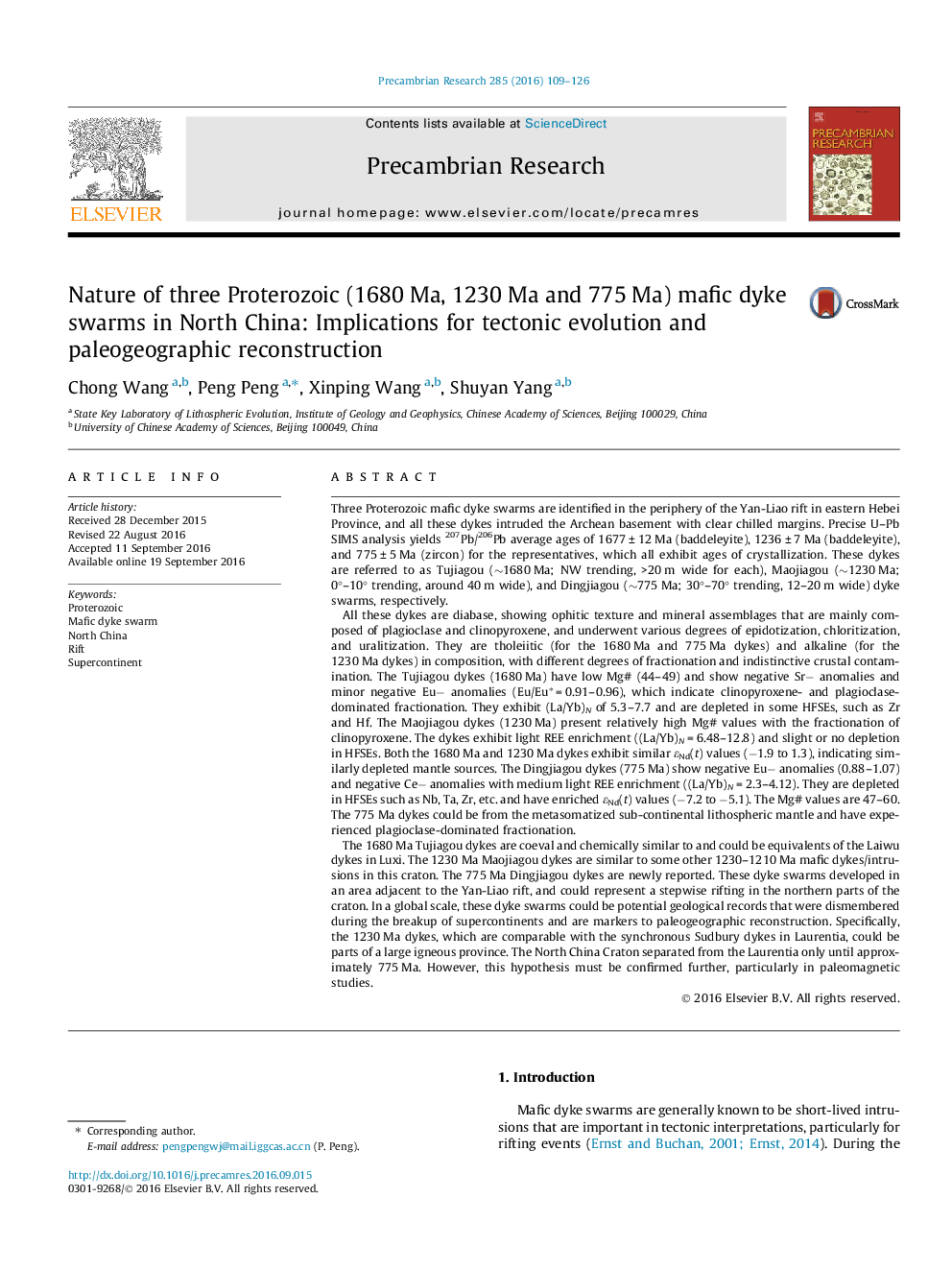| کد مقاله | کد نشریه | سال انتشار | مقاله انگلیسی | نسخه تمام متن |
|---|---|---|---|---|
| 4722344 | 1639590 | 2016 | 18 صفحه PDF | دانلود رایگان |

• Three Proterozoic dyke swarms are identified and dated from North China craton.
• They indicate a prolonged but stepwise evolution of the Yan-Liao rift during ∼1720–775 Ma.
• The 1230 Ma dykes may match those in Laurentia, suggesting a physical connection.
Three Proterozoic mafic dyke swarms are identified in the periphery of the Yan-Liao rift in eastern Hebei Province, and all these dykes intruded the Archean basement with clear chilled margins. Precise U–Pb SIMS analysis yields 207Pb/206Pb average ages of 1677 ± 12 Ma (baddeleyite), 1236 ± 7 Ma (baddeleyite), and 775 ± 5 Ma (zircon) for the representatives, which all exhibit ages of crystallization. These dykes are referred to as Tujiagou (∼1680 Ma; NW trending, >20 m wide for each), Maojiagou (∼1230 Ma; 0°–10° trending, around 40 m wide), and Dingjiagou (∼775 Ma; 30°–70° trending, 12–20 m wide) dyke swarms, respectively.All these dykes are diabase, showing ophitic texture and mineral assemblages that are mainly composed of plagioclase and clinopyroxene, and underwent various degrees of epidotization, chloritization, and uralitization. They are tholeiitic (for the 1680 Ma and 775 Ma dykes) and alkaline (for the 1230 Ma dykes) in composition, with different degrees of fractionation and indistinctive crustal contamination. The Tujiagou dykes (1680 Ma) have low Mg# (44–49) and show negative Sr− anomalies and minor negative Eu− anomalies (Eu/Eu∗ = 0.91–0.96), which indicate clinopyroxene- and plagioclase-dominated fractionation. They exhibit (La/Yb)N of 5.3–7.7 and are depleted in some HFSEs, such as Zr and Hf. The Maojiagou dykes (1230 Ma) present relatively high Mg# values with the fractionation of clinopyroxene. The dykes exhibit light REE enrichment ((La/Yb)N = 6.48–12.8) and slight or no depletion in HFSEs. Both the 1680 Ma and 1230 Ma dykes exhibit similar εNd(t) values (−1.9 to 1.3), indicating similarly depleted mantle sources. The Dingjiagou dykes (775 Ma) show negative Eu− anomalies (0.88–1.07) and negative Ce− anomalies with medium light REE enrichment ((La/Yb)N = 2.3–4.12). They are depleted in HFSEs such as Nb, Ta, Zr, etc. and have enriched εNd(t) values (−7.2 to −5.1). The Mg# values are 47–60. The 775 Ma dykes could be from the metasomatized sub-continental lithospheric mantle and have experienced plagioclase-dominated fractionation.The 1680 Ma Tujiagou dykes are coeval and chemically similar to and could be equivalents of the Laiwu dykes in Luxi. The 1230 Ma Maojiagou dykes are similar to some other 1230–1210 Ma mafic dykes/intrusions in this craton. The 775 Ma Dingjiagou dykes are newly reported. These dyke swarms developed in an area adjacent to the Yan-Liao rift, and could represent a stepwise rifting in the northern parts of the craton. In a global scale, these dyke swarms could be potential geological records that were dismembered during the breakup of supercontinents and are markers to paleogeographic reconstruction. Specifically, the 1230 Ma dykes, which are comparable with the synchronous Sudbury dykes in Laurentia, could be parts of a large igneous province. The North China Craton separated from the Laurentia only until approximately 775 Ma. However, this hypothesis must be confirmed further, particularly in paleomagnetic studies.
Figure optionsDownload as PowerPoint slide
Journal: Precambrian Research - Volume 285, October 2016, Pages 109–126